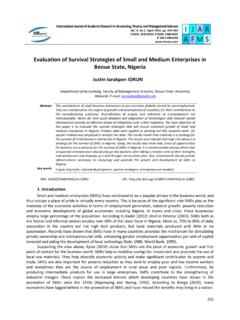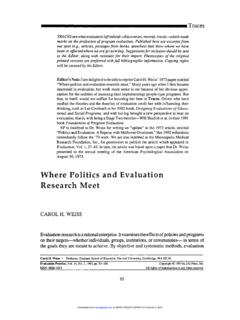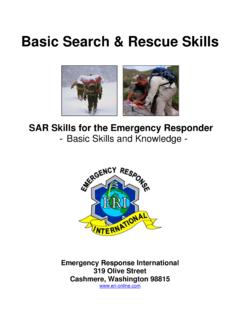Transcription of Basic Life Support Instructor Course Faculty Guide
1 Basic life Support Instructor Course Faculty Guide May 2013. 2013 American Heart Association Contents Introduction .. 3. Background .. 4. The Early Days .. 5. AHA Mission .. 6. AHA Global Mission .. 6. Emergency Cardiovascular Care Mission .. 6. The Science Process and Why Materials Change Every 5 Years .. 7. Turning Science Into Training .. 8. Making an Impact .. 9. The Instructor -AHA 10. How the BLS Instructor Course Works .. 10. Step 1: Prepare .. 11. Prepare Yourself .. 11. Find or List a 12. Prepare the Materials and Paperwork .. 13. Prepare the Equipment .. 15. Prepare the Room .. 16. Prepare the Instructor Candidate .. 18.
2 Step 2: 20. Overview of Competencies .. 20. Ethical and Professional Considerations .. 21. Faculty Role and Video-Based Lessons .. 22. Using Lesson Maps .. 22. Sample Course Agenda .. 24. Course Outline .. 25. Cleaning Manikins .. 28. BLS for Healthcare Providers and Heartsaver Audiences .. 28. Step 3: Test .. 29. How to Test Instructor Candidates .. 29. Monitoring Instructor Candidates .. 29. Step 4: Close .. 30. Participant Evaluations .. 30. Next Steps .. 30. Paperwork .. 30. 30. 31. Step 5: Keep Current .. 32. Resources for AHA Updates .. 32. Maintaining Faculty Status .. 32. Forms .. 32. Lesson Maps .. 33. 2 BLS Faculty Guide Introduction Welcome to the American Heart Association (AHA) Basic life Support (BLS) Instructor Course Faculty Guide .
3 This Guide is for BLS National Faculty , Regional Faculty , and Training Center Faculty who are teaching a BLS Instructor Course . At the AHA National Center, we often get questions about how the AHA works overall and where these courses fit into the broader AHA spectrum. The following is information that answers those questions, and you may find it useful to share with Instructor candidates. 3 BLS Faculty Guide Background The Early Days AHA Mission AHA Global Mission Emergency Cardiovascular Care Mission The Science Process and Why Materials Change Every 5 Years Turning Science Into Training Making an Impact The Instructor -AHA Partnership How the BLS Instructor Course Works 4 BLS Faculty Guide The Early A pioneering group of physicians and social workers formed the Days first Association for the Prevention and Relief of Heart Disease in New York City in 1915.
4 They were concerned about the lack of heart disease information. At that time, patients with heart disease were considered doomed, limited to complete bed rest. So these physicians conducted studies in New York City and Boston to find out whether patients with heart disease could safely return to work. Similar groups in Boston, Philadelphia, and Chicago evolved into heart associations in the 1920s. Interest spread widely in other cities across the United States and Canada. Recognizing the need for a national organization to share research findings and promote further study, 6 cardiologists representing several groups founded the AHA in 1924.
5 Here is a timeline of some key dates and events in the AHA's history: 1924 The AHA was founded. 1948 The AHA was transformed from a scientific society into a voluntary health agency with national headquarters located in New York City. 1975 A rapidly growing AHA moved its National Center to Dallas, Texas, to better serve affiliates and local divisions nationwide. 1980s The AHA gained a foothold as a visible champion of public health. The AHA developed guidelines for the nation's healthcare system and supported the federal government's attempt to improve access to healthcare. The AHA focused its planning in 3 areas: cardiovascular science, cardiovascular education and community programs, and fundraising efforts.
6 Mid-1990s The AHA's scientific findings began to move more quickly from laboratories and clinics to physicians'. offices and American households. 1995 The AHA's strategic driving force for moving into the 21st century became providing credible information about heart disease and stroke for effective prevention and treatment. 5 BLS Faculty Guide AHA Mission The AHA mission is to build healthier lives, free of cardiovascular diseases and stroke. That single purpose drives all we do. The AHA is the nation's oldest and largest voluntary health organization dedicated to saving people from heart disease and stroke, America's No. 1 and No.
7 4 killers, respectively. The association is the trusted leader in emergency cardiovascular care and trains people around the world in how to save lives with CPR. and first aid. AHA Global Through collaboration with global partners and through Mission knowledge transfer of its proven programs and strategies, the AHA. strives to reduce the global burden of cardiovascular disease and stroke. Emergency The AHA's Emergency Cardiovascular Care (ECC) Programs Cardiovascular department is responsible for implementing program initiatives Care Mission and providing guidance and Support to the ECC Training Network. The ECC mission supports this responsibility.
8 The mission of ECC Programs is to reduce disability and death from acute circulatory and respiratory emergencies, including stroke, by improving the Chain of survival in every community and in every healthcare system. ECC Guiding Philosophy: Improve the Chain of survival in every community Increase quality and timeliness of materials Identify and expand training Document effectiveness Improve efficiency The goal of ECC Programs is to be the world's premiere resuscitation organization and serve the global community of scientists, healthcare providers, and citizens as a critical leader in discovery, processing, and transfer of resuscitation science.
9 Its programs, products, and services focus on maximizing survival from life -threatening cardiovascular emergencies. 6 BLS Faculty Guide The Science Scientists and physicians from the International Liaison Process and Committee on Resuscitation (ILCOR) continuously evaluate Why current and new evidence about resuscitation. Every 5 years, Materials ILCOR holds an International Consensus Conference, during Change Every which these scientists and physicians discuss and debate and then 5 Years come to a consensus about the best ways to apply the science in resuscitation. This is documented in the ILCOR International Consensus on CPR and ECC Science With Treatment Recommendations.
10 The AHA is a member council of ILCOR, and the AHA. Guidelines are written on the basis of the ILCOR consensus. ILCOR International Consensus . AHA CPR and ECC Guidelines . ECC Training Materials This process allows the AHA to incorporate the most current science into its materials, so that Faculty , instructors, and students have up-to-date information on the best practices. 7 BLS Faculty Guide Turning The 2010 AHA Guidelines for CPR and ECC are based on the Science Into most current and comprehensive review of resuscitation literature Training ever published, the ILCOR 2010 International Consensus on CPR. and ECC Science With Treatment Recommendations.







